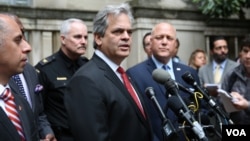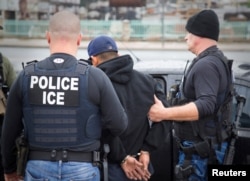U.S. President Donald Trump's tougher stance on immigration enforcement has led to an increase in non-criminal arrests, but not an unprecedented one.
Trump's January 25 executive order “Enhancing Public Safety in the Interior of the United States” changed the rules governing immigration by opening the door to arrest immigrants whose only crime was being undocumented.
In the last two years of his term, President Barack Obama had largely confined immigrant arrests to those who had committed a serious crime.
From January to March, U.S. Immigration and Customs Enforcement (ICE) says it arrested 21,362 immigrants. Out of those, 5,441 were of non-criminals.
In 2016, under the previous administration, 2,278 non-criminals were arrested. During the same months in 2015, that number was 2,342. But non-criminal arrests were dramatically higher in early 2014 when 7,483 immigrants, not convicted of a crime, were arrested.
Later in November 2014, Obama changed his detention policies to shield non-criminals.
trump
Deportation numbers
The ICE report also includes removal figures — people who were arrested and deported to their home country. Between January and March of this year, ICE conducted 54,936 removals of individuals illegally in the country. Almost half of those deported were non-criminals.
Sarah Rodriguez, an ICE spokeswoman, said over email that removal figures can “fluctuate by month based on a number of factors, so a few months' removal statistics should not be used to determine any long-term trend.”
And TRAC, the Syracuse University's Transactional Records Access Clearinghouse, reports that U.S. Department of Homeland Security (DHS) issuances of NTAs (notice to appear) that initiate proceedings in Immigration Court prior to removal continues to be about the same.
TRAC, which has been building a baseline using case-by-case records of both apprehensions and removals, cautions that delays in filing and recording make the numbers very preliminary — and that many of the NTAs appearing during Trump's first three months were initiated during the Obama administration.
But the TRAC data does show a sharp difference in whether people are detained or released while their cases are being tried.
TRAC says only 25 percent of people arrested under the three-month Trump administration have been released; the rest remain detained.
During the eight-year term of President Barack Obama, about 54 percent of those arrested were later released.
ICE field offices
Some ICE offices showed more activity than others.
Atlanta, Chicago and Dulles showed, from Jan. 20 to March 13, the highest arrest numbers of immigrants without criminal convictions.
ICE's Atlanta office arrested 697 undocumented immigrants without criminal records. In 2016, that number was 137.
Other ICE offices doubled or tripled their arrests of criminal and non-criminal undocumented immigrants.
Local authorities worried
Increased arrests and the fear of additional arrests have some local officials worried because they fear that immigrants will stop reporting crimes. Drops in crime reports have been reported in the Washington D.C. area, Houston, and Los Angeles.
“We're hearing from many cities throughout the United States that right now folks, immigrants and Latinos, are less likely to report a crime if they are a victim or less likely to step up as witness if they witness a crime because of the fear of deportation," Jorge Elorza, mayor of Providence in the state of Rhode Island, said after a group of mayors had an hour-long meeting at the Department of Justice with U.S. Attorney General Jeff Sessions.
Rodriguez said ICE “recognizes” the importance of crime victims and witnesses coming forward, and the agency will work closely with state and local law enforcement to see that foreign nationals — who are victims of domestic violence, sexual assault, and human trafficking crimes — are informed about the availability of special visas to enable them to remain in the U.S.
Public safety is top priority
The mayors were all in agreement that their first priority is to maintain public safety, and they vowed to resist any suggestion of transferring local resources to enforce immigration laws.
“We certainly are going to resist any suggestion that we transfer those resources and to focus on (undocumented) folks that forgot to put a turning signal on or perhaps didn't fully stop at a stop sign,” Elorza said.
Local police do not have the resources or the time to act as federal immigration agents, mayors said.
“It erodes the trust that quite frankly cities like Austin have spent a lot of time and a lot of money,” Steve Adler, Mayor of Austin, Texas, told reporters.
Earlier this week a U.S. District judge in San Francisco put a temporary stay on a Trump executive order threatening to cut off federal funding to local governments that refuse to cooperate with immigration authorities to detain illegal immigrants arrested in criminal cases, often for minor offenses.
Trump has vowed to appeal the ruling to the Supreme Court.











